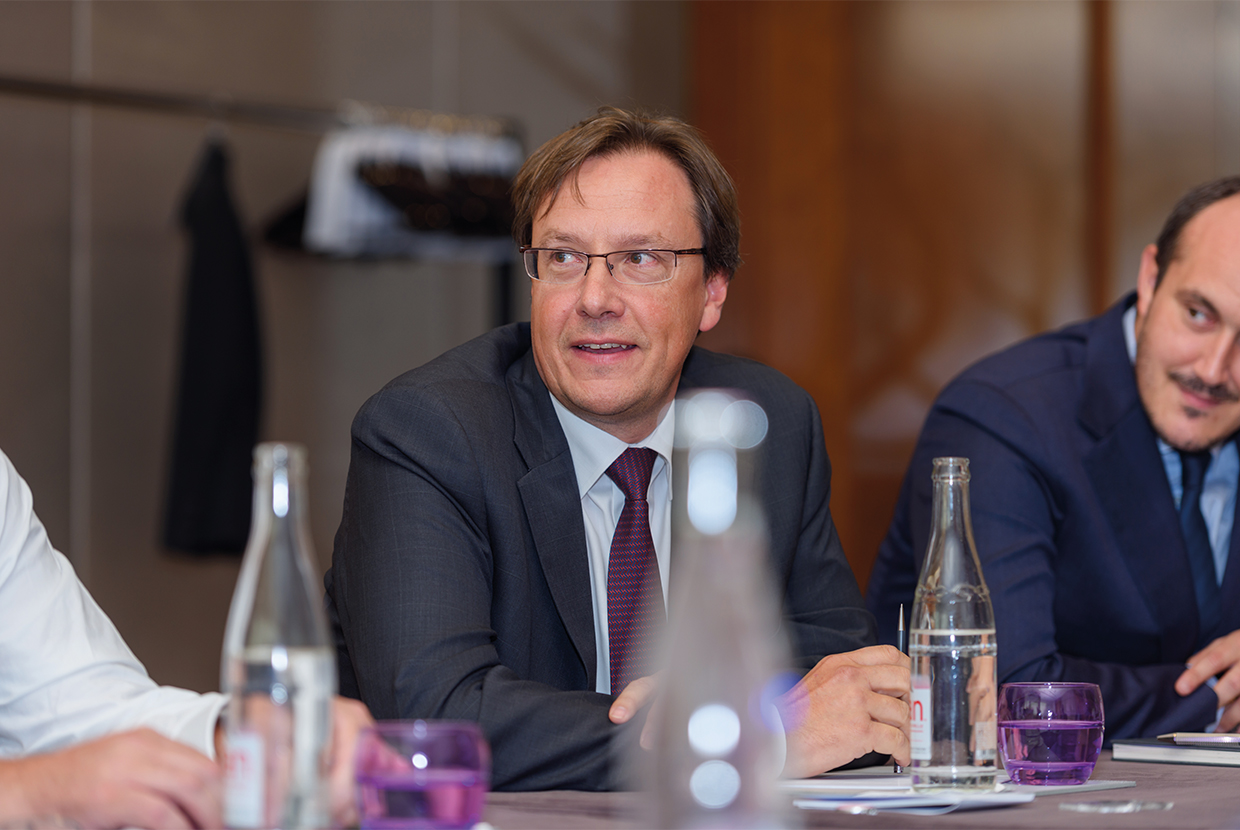GTR’s annual commodity finance table drew together a group of global and regional banking heads, as well as representation from the insurance and fintech sectors, to discuss the impact of geopolitical shifts on the industry, the case for technological advancement and the growing drive towards greater sustainability.
Roundtable participants:
- Bob Angliss, deputy head of commodity centre, Bank of China
- Souleïma Baddi, CEO, komgo
- Sam Evans, director, BPL Global
- Alexandre Dietz, head of trade and commodities Switzerland, HSBC
- Rui Florencio, global head of energy and metals commodities, ABN Amro
- John MacNamara, vice-chairman trade finance commodities (speaking prior to his retirement at the end of September), Deutsche Bank
- Kris Van Broekhoven, global head of commodity trade finance, Citi
- Jasper van Schaik, global head of trade and commodity finance, Rabobank
- Sanne Wass, senior reporter, GTR (chair)
GTR: There are currently several geopolitical tensions and uncertainties in the world. We’ve had the ongoing US-China trade war, Brexit, tensions around Iran, and a recent attack on a Saudi oil site. How is all this turbulence impacting your business, and are there any specific developments that you are following in particular?
MacNamara: Trade finance is about perception of risk. And anything which increases the perception of risk is actually quite good for trade finance as an industry, because if there is no perception of risk, everybody is happy to do everything unsecured. So brutally, a certain element of global crisis is always good for that perception of risk.
Dietz: We are watching the market very closely. We don’t think that anything has really impacted our strategic priorities so far. We are very careful in the way we are approaching things, but at the same time we see that trade has grown. For 2018, this growth was 4.8%. If we look at intra-Asia, it’s at 7.1%. And then for 2019, it’s expected to be again close to 4%.
Van Broekhoven: Geopolitical tensions can impact the business and trade in two ways. There are negative consequences when it comes to sanctions. Obviously, it’s a binary situation. If you can’t work with a certain country or certain counterparties, you can’t do business. If you used to do business with them, you don’t have it anymore. However, there can also be a positive impact. We have seen a change in certain flows caused by the most recent trade war between the US and China. For instance, where there was a direct flow of US soybeans or crude oil into China that is no longer there, that trade is replaced with two other trades, one for the US goods to go to Latin America or Europe, and another for China to import those same goods from other sources. So we end up financing multiple flows rather than one.
Florencio: If you have flows changing, that is good for the industry. In general, it’s not nice for the world, but it’s good for the industry. Unless you get caught out in the wrong country. But in general, things changing is good.
Angliss: You’ve got to look at the way that the bank looks at geopolitical risk, and let’s face it, whilst we as practitioners in this business probably look at something and say that it’s a really good idea, if you go and talk to your risk guys, the first thing they do is look at the problems. And obviously, the other factor is the market. Geopolitical risk gives more opportunity for the market, especially for the trading companies to identify further optionality.
Geopolitical risk in terms of the commodity business is always a double-edged sword. It’s good on one hand, and bad on the other. Traders are very clever people. They like to see some kind of volatility. It gives them the opportunity to do things, but for banks it’s become harder over the last 10 years to do the more difficult things that perhaps we were doing prior to 2008, because of the lack of risk appetite. Everyone is being much more cautious. And the more tensions, the more geopolitical risks we’ve got in the market, which makes it that much more difficult to do things.
GTR: When you say that these uncertainties provide opportunities, does that mean you are financing more?
Angliss: We had the Saudi event. Immediately, everyone in risk is worried, but actually, the price has gone up, so all the deals that you did a year ago are fine. They’re in a better position.
Van Broekhoven: It creates a lot of noise internally but it doesn’t really impact the number of transactions you can do.
van Schaik: Geopolitical tension is also not new. We have seen this before. It isn’t really affecting the banks who have the option to diversify. I agree that you will bring your soybeans from South America rather than from the US, but as far as it can have an impact on prices, we have seen a number of prices drop. Is that an effect of the trade war? Probably not, but some of it may be related to economic growth in China, to exchange rates, and where it really impacts us is that we have a lot more work to do today.
There are also a lot of sanctions and, at least from our side, the repercussions on the banks are much larger than 20 years ago, so you really have to know what you are doing, especially on the transactional side. We are investing heavily in this; every time there is a new sanction, you always need to go through all the files globally and check everything. But I assume that’s the same for most of the banks. It’s a lot more work and attention on that side.
Angliss: The geopolitical tensions have always been around. Look at Sonangol. You can’t get much more geopolitical tension than a country with a civil war, and yet they were still financing the crude oil coming out of Angola. It’s the nature of what we live with.
Van Broekhoven: What matters most for all of us in commodity trade finance is that we do organise our business to deal with any eventuality in terms of high prices or low prices, and we do monitor our transactions closely. This helps us to manage our business when internally people are paying attention to the increase of risk.
GTR: What about from the insurance point of view?
Evans: Whether it is a perceived increase in geopolitical risk, or whether it is actually a true increase – because as you have all said this isn’t the first time that we have had attacks on refineries globally – who knows? But I think it is worth pointing out that banks and traders are inherently risk averse. The market that I represent, the credit and political risk insurance market, has become vital and inherently linked to trade finance, and I would like to think that as the diversification which you were speaking about grows, the insurance market is there to support that flow and becomes even more significant.
There has been an increase in capital into the credit and political risk insurance market in recent years. It is very buoyant. There have been some issues of tightening of lines on the private buyer and private obligors, and so small traders have felt the pinch on that and it has been hard work explaining that to some clients, but generally, the insurance market is buoyant and is supporting you in what you are doing in the trade finance sphere. Commodity trade finance still represents 20% of our insured book for BPL’s clients, which is equivalent to about US$10bn in exposure, so it is still hugely significant.
GTR: Are the bankers using more insurance now as a result of these events?
MacNamara: We have always used insurance. The big drivers of insurance tend to be regulatory, so Basel II opened the door to using a lot of insurance, Basel III reduced the benefit of the insurance, Basel IV I think will open certain doors.
I don’t particularly worry about these one-off events like Saudi production dipping for a short period. I worry more when people talk about there being a big recession looming. What other precursors are there? Normally in commodities, we are at the front end of every cycle. And I don’t know whether it is cause or effect, but when prices start coming off across the board, that is usually not a good sign.
I worry more about the news coming out of China, to be honest, because they are the biggest buyer of everything.
GTR: Are these uncertainties here to stay? Do you expect more uncertainties, or is this just a short-term issue?
Van Broekhoven: A more recent phenomenon is that the geopolitical scene has an impact on global growth. For most of our careers, we have lived in a world that kept on growing. World GDP really slowed down a few years ago, and it does have an impact on our businesses. We all have targets to grow revenues, and if we can’t grow organically, we have to do something else. If we can’t do that, we have to start saving costs.
Angliss: I don’t think you are wrong, but there is such a thing in commodities in particular of being right too early. We have been waiting for some of these things to happen for a very long time, and eventually, if you are right sufficiently early, you are wrong.
GTR: Can technology solve the major problems in the commodity finance space?
Baddi: Not the geopolitical issues, that’s for sure. If you look at this industry, technology is a never-ending debate. Contrary to the capital markets industry, commodity markets have never adopted a tech solution at a large scale. There are some successful projects in some places of the world, but it’s not enough to make this industry more efficient and more safe.
Dietz: And at some point, given the low margin environment we are living in today, if you don’t move big-time to technology at a very high level, you are out of the game. There needs to be a drastic change.
Florencio: The discussion is often very polarised. Clients like to pick up the phone and have somebody they can call, but then often you get these discussions where on one side, if you look at technology, it is as if all the humans disappear, and on the other side if you’ve got no human, you’re going to have a problem. What you need to do is make it super-efficient, super-quick, and if something isn’t great, you can still pick up the phone.
Baddi: Clients can still pick up the phone to us. The big difference today is that people are realising that they don’t have any other choice than to change. Technology is not going to solve all the problems of the industry, but I think the industry today is realising that it has no choice than to move given the low margins, high level of fraud and massive increasing regulatory requirements.
MacNamara: We have moved a long way without even realising it. Every time we look at our phones to look something up, or even to find the address of the client, we take it all for granted, and that soft creep into technology is just going to keep growing exponentially.
Angliss: I think everyone is looking at technology and thinking it is going to change everything. It isn’t. It’s just going to be another tool.
van Schaik: We just discussed capital requirements. I don’t think the capital requirements will be going down, so either we jack up the revenues, which is going to be a challenge, but then we need to look at some of the repetitive stuff that we are doing and apply technology to that.
Angliss: Technology is not going to cover everything that we do in commodity finance, but it will cover a large percentage of what we do. What it will do is reduce the costs in handling for the banks, reduce the costs for the traders, and therefore make it that much quicker.
Dietz: The way to look at technology is not to look at the human creating the technology. It is to look at the technology and say, do we need a human there? It is how to automate the processes that are heavy in terms of cost and say, do we really need a human to perform this task?
MacNamara: A lot of us fear investing in the wrong technology and at a certain stage, banks and their clients need to decide what platforms they are going to use.
GTR: Where are the use cases in your business where technology can really make a difference?
Van Broekhoven: We all agree that digital transformation is needed and is on its way in. But there is a lot more talk than action today. The big challenge is that the market is so connected today with all the players interacting with each other that whatever is the solution today should actually be the solution for many, many parties at the same time for it to take off and be scalable. That’s a challenge.
Baddi: The important thing is to bring added value to your users, at the end of the day. So, how can this platform make life easier and more secure for everybody? This is where it becomes difficult, because as you know, this industry is tailor-made.
We have tried to bring value with a wide range of products. We have been working on the letter of credit, the standby, we have been working on receivable discounting, KYC. We also use our network to stamp documents to mitigate fraud risk: all user invoices can be securely sent via komgo today. When you connect with this platform, you do it for many reasons. We have tried to make it as user-centric as possible because we know it is a big cost for people to invest into this new technology.
Dietz: What we see today is that there are many, probably competing, initiatives. I don’t think that one system is better than the other. I think the key to success is interoperability between the systems. Blockchain technology allows us to have systems which can talk to each other.
Baddi: Being interoperable is super important, but it has to bring value to the users. You only do it if it brings value to the users.
GTR: For the banks here who are perhaps involved in some of the initiatives, what are the biggest challenges?
MacNamara: Technology does go wrong. Who has not had the experience of coming into the office and being unable to log on, or where the data integrity of what you find is wrong for some reason? And I wonder, how confident are you in the quality of your technology? Because technology has been a disappointment to me if I’m honest on so many functions.
Baddi: When you do an enterprise grade platform, you need to meet very high standards. It’s an everyday challenge for us to maintain this, and we have to match those standards. It is kind of the basic rule if you want this to succeed, so this was our first focus. We did a penetration test with a third party before the platform was launched. Technology is not the biggest challenge here. The biggest challenge is the business.
Florencio: We invested in komgo, and that is where we are now looking to make that shift as a user. We have found that they are looking to hear from us about what we need to make it work. And I think that is an important element.
Baddi: We are trying to run the platform based on something that suits the needs of the users.
van Schaik: We are talking about blockchain, but it’s still not yet running. Three years ago, people would have predicted by now that 30 or 40% of global trade would be done on blockchain. However, people always overestimate what is possible in the short run, and underestimate what is possible in the longer run. We are strong believers that blockchain will become very relevant in our world in the coming three to five years.
Dietz: All the systems are now working. You have the innovators, you have the first mover, and then you have the mainstream. And the problem is that three years ago, we saw companies that were the first movers. But the problem is how to engage all the stakeholders that you want on the table, to get them to adhere to the platform. The freight company, the eBL company, the surveillance company, the shipper and the commodity bank; the key to the success is to bring all of those people together.
Van Broekhoven: The main reason why we can’t say that blockchain has taken off yet is not because blockchain is not working. It’s because it takes such a long time to actually get something in production and then give people the time to test it and experience it.
Dietz: We need to start with oil traders, because we know how traders are operating, because they invented the LOI far before everybody. So, working with traders is easy.
Baddi: I wouldn’t say that. Even with traders, it is a challenge.
Van Broekhoven: One of the reasons why Citi was an early investor in komgo is because we wanted to learn about the technology. It is new technology for all of us in the industry. And if we really believe that there is going to be an ecosystem developing around technology, then we need to understand what it is. You only learn about the detail once you are involved in the project.
MacNamara: With blockchain, you can kiss a lot of frogs looking for your prince. There are lots of frogs and not many princes. And we are still waiting to see what will be the platform that everyone will go to.
GTR: How many of you are investors in komgo? Are you actively using the platform now, and what are the biggest challenges in order to really get started?
Angliss: The reality of it is that the technology is going to be an important part of our business going forward and it will be driven by the fact that the traders will need to have that technology. What the traders want is what we want from it. The problems arise when it comes to the bank’s internal systems and internal infrastructure.
Every bank has exactly the same problems. You can have a very efficient system, which I think komgo is, but trying to fit that into the way that your own systems operate is going to make it much more difficult.
MacNamara: Most of the systems don’t necessarily talk to each other within the same firm, so getting them to talk to a system outside of the firm strikes me as quite a long-term project.
van Schaik: Banks are now making big investments in replacing their old legacy systems. This is very necessary, as it is for us to be able to interface with digital platforms like komgo, in which we have also invested.
Van Broekhoven: If you want to extract maximum value from digital platforms you have to integrate your systems with the platforms that are being built externally. So first you work closely with the technology teams that are building the platform. As an early adopter or investor, you have early access to the developers, which allows you to understand what is behind the platform. Then we do our own security reviews and testing. At Citi we have already moved on to integrating our own legacy systems with what komgo is building.
GTR: The margins have become better. Is this because of technology?
Dietz: Today, when you start to process fewer documents, and when you don’t lose three days of working capital in the transaction, you start to save very important amounts of money, especially in a very poor margin environment.
Evans: It’s quite fascinating to hear the similarities between both of our industries. There is nothing more antiquated than Lloyd’s of London in lots of people’s eyes. And when you talk about the commodity finance industry, like insurance, it is very much people-focussed, because people want those face-to-face conversations. However, even Lloyd’s of London is going digital. It is inevitable that the technology is coming, but it will take a bit more time to get into this complex area of business.
There is now a system called Toredo which is for trade finance, and there are increasing numbers of platforms such as that, but as we said before, it is about how they interface. If you have three underwriters on one platform and seven on another, it is too complicated. There needs to be something that runs across the whole industry that trade finance banks or commodity traders can tap into.
GTR: Can you imagine insurance being integrated with some of the projects that are already going on?
Baddi: For us, insurers can be a user like anyone else.
GTR: Over the last few years we have seen commodity trading companies raising sustainability-linked loans. What drivers are behind these types of facilities, and how is that process different from a usual revolving credit facility?
Florencio: We basically want a role where we promote the transition into a more sustainable way of producing. We found a good client of ours, and in the loan that we made, the emission targets were part of the targets on the loan, and there would be a discount, or an uptake, and that’s why we called it a positive impact, depending on the performance of the client in that prospect.
It is important to do those things. It is not easy always to find the right deals with the right motivation. Sometimes it’s a bit scary. But if you are in our market, I don’t think you can shy away from it. The perception of what the bank should be from the public is changing. If you look across the new generation of people that we hire, they really look at their purpose completely different than other generations.
When you look at the outside world and your reputational risk, you also have to make a positive impact, and that is a big change, because I think the scrutiny on hard-core returns is harder than ever inside banks. At the same time, you have technology coming up which takes a lot of time, and you do projects which take a lot more time and are much more purpose driven. Balancing all those is a challenge, but you need to do it. I don’t think the new generation who work for banks just want to make profit.
MacNamara: Trade finance is in danger of underselling itself in this respect, and export finance as well. Already in the 1990s, the export credit agencies were demanding environmental protections and incremental improvements as a condition of providing insurance cover, finance, the lot. That sort of thing has been going on for years, it just hasn’t been publicised. We have always had environmental law compliance clauses in our loan documentation, and this is radical. It’s not new, it’s been around for 20-odd years. You’re absolutely right in your analysis of the world that demands that we play our part. There is always more to do, but we just haven’t been advertising it. Having some conditionality in your loan agreement has been there for a very long time.
GTR: Why are banks doing sustainability-linked loans?
Dietz: It is driven by the clients. You talk to the CEO of any company, and it is top of the agenda.
MacNamara: Also, we have got children too. We want a clean planet. At every Chinese factory I have been to in the last few years, ever since the government turned around and said that they wanted to clean the sky up, the first thing they say is that their top priority is environmental improvement. And you see now all these pictures from the site visits in China and they include a clear blue sky.
Dietz: Sustainability is the way to maintain the business, period. And therefore, banks have had to develop products that suit clients’ needs.
MacNamara: It is not just virtue signalling. A lot of banks do it because it’s the right thing to do. As a commodities team, we look at every single transaction that is part of our key operating procedures, and we have a sustainability and environmental risk assessment per deal. And we have done this for decades. The challenge a lot of the time is that the standards change, so if you remember in the early noughties, everybody wanted diesel, because it reduces the carbon footprint, and then several years later, we realised it pushes particulates through the roof and it’s worse. What was the environmental rule then has become a different environmental rule now, so you have to stay on top of it.
van Schaik: Banks are more in the driver’s seat of engaging with clients on making improvements on environmental issues. This is not only about adhering to the applicable laws, because you need to, but also because we want to make a change.
Van Broekhoven: We all believe that the world has to be improved and that as large institutions we have a responsibility as a corporate citizen to contribute to that. Banks can do various things. They can analyse the market and what is going to happen in the next few years, and look at the potential impact on their portfolio, their clients, and particular industries. Then they can help the industry to navigate the transition towards the new norm. You can do that via loans that are sustainable, by incentivising your corporates to score high on ESG performance criteria. At the same time, at Citi we do promote transparency, and we already see a growing number of corporates report on these metrics.
Angliss: At Bank of China, we put a sustainability factor into our business proposals. We have been looking at climate change and the impact that it has, and what we can look at in terms of the new business that we can do which has a better impact on the client.
GTR: If banks are subsidising sustainability through cheaper loans, is that really a sustainable solution?
Angliss: I don’t think you can say that the banks are subsidising. They are not. They are looking for opportunities, and I think one of the things that we have discussed within Bank of China is perhaps giving more focus to those transactions which are more sustainable or climate-friendly.
Florencio: It’s about the motivation to do things that are right. And sometimes it’s pricing, sometimes it is not. Sometimes it is structure. Sometimes it is just attention. So, there are a lot of different elements to being positive about this type of loans.














